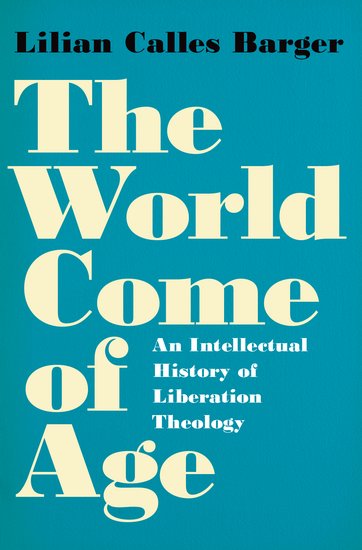Editor's Note
This is the fourth post in our roundtable on Lilian Calles Barger’s book, The World Come of Age: An Intellectual History of Liberation Theology (Oxford University Press, 2018).
“The theology of the free church, then, I would suggest is a secular theology, that worldly interpretation of the gospel toward which Bonhoeffer was groping during his last days in prison.” (171)
It is the intellectual history of this “worldly interpretation of the gospel” with which The World Come of Age
is concerned. When Feminist theologian Rosemary Radford Ruether penned the above quote in the late 1960s, she did so in an attempt to open the eyes of her readers to the efficacy of religion in bringing about women’s liberation. As Lilian Calles Barger’s new work shows, however, this statement not only encapsulates the sentiments expressed by liberators of women, but by those seeking the liberation of black Americans and Latin Americans as well. All three groups, she argues, sought to respond to a world that, in the words of Dietrich Bonhoeffer, had “come of age”—a world in which humankind was “responsible for itself without recourse to a God far removed from the world.” (5) Those liberators involved in Black Power, women’s liberation, and Latin American revolutionary movements thus adopted and adapted a theology that took as its starting point the experiences of the oppressed. In doing so, Barger argues, they secularized the religious and sacralized the political, destroying the boundary between the sacred and the secular in the process.

In many ways, Barger’s sweeping work serves to free liberation theology itself from narrow conceptions of the term as strictly Latin American, Catholic, Marxist-inspired, and violence-oriented. While some of these characteristics may be accurate in describing certain iterations of liberation theology, Barger contends that such characterizations have obscured a more diverse and complex history. The World Come of Age recovers this historical complexity. The story that emerges is not one of linear ideological development, but a concurrent evolution of three distinct, but related, liberation theologies. One area in which similarities and differences among these groups emerge is in the uses of their respective pasts to legitimize these new theologies. These groups collectively eschewed a realist, Rankean interpretation of the past, instead constructing group histories that located meaning in the experiences of their predecessors. Despite this shared emphasis on developing historical foundations for emerging theologies of liberation, these groups differed in their particular uses of the past. Latin American liberationists saw in their history an eschatological teleology, a movement from oppressive colonization toward freedom from corrupt governments and a complicit Catholic church. For these revolutionaries, to act in history was to move with the flow of that history toward freedom for the oppressed. For black and feminist theologians, their uses of the past were histories of recovery that highlighted previously silenced voices which they channeled into calls for liberation. All of these interpretations, however, saw in history a divine call for human liberatory action in the secular world.
For political theologian Jürgen Moltmann, this past “suffering in history anticipated future relief through hope.” (149) Other theologians such as Johann Baptist Metz built upon this idea to argue that secularization grew out of the Christian past and was the natural outcome of the freeing of theology from the strictures of religion, bringing salvation—understood in a socio-political sense—to the world. In a departure from a social gospel that presupposed the necessity of traditional churches and theological constructs, each stream of liberation increasingly reconciled the religious and the secular in the years after midcentury. Bonhoeffer’s earlier calls for the recognition of a crucified God acquainted with human suffering met the societal upheaval of the 1960s in the political theologies of thinkers like Gustavo Gutierrez, James Cone, Mary Daly, Rosemary Radford Ruether, and Johann Baptist Metz. Of Barger’s three interwoven arguments, this assertion regarding the relationship between the sacred and secular stands out to this reader as particularly striking. She writes that, “by challenging the sacred/secular divide of modernity, liberationists reshaped the terms of engagement and opened the floodgates for a full-throttled entry of religious claims into the political sphere.” (5) In this way, Barger sees liberation theology as playing a direct role in the rise of the Religious Right, not only in rousing conservative fears of radicalism, but in claiming religious motivation for political action. She also notes the larger failure of most liberation theologians to build new socio-political and economic structures in the places of those they attempted to overturn.
As the book’s epilogue notes, however, this trajectory did not spell the end for the liberators of blacks, women, and Latin Americans after the 1970s. Barge explains that the rhetoric and goals of liberation theology would again see new life, albeit rhetoric espoused not by theologians, but by everyday liberators in the ranks of the Rainbow Coalition, the Re-Imagining Conference, Occupy Wall Street, and Black Lives Matter. This shift can indeed be seen as a secularization of what were once explicitly religious movements, but also as the successful transference of theological ideals to the secular. This narrative encourages the reader to reimagine what constitutes the success and failure of liberation theology in the present day. One wonders in which ways the trajectory of liberation theology charted here interacts with the broader historiography on secularization and desecularization. One thinks specifically of David Hollinger’s Post-Protestantism thesis, in which the perceived decline of mainline Protestantism was in reality the result of the establishment’s success in seeing its values adopted by the broader society, at least in the United States. Whatever its interaction with such histories, however, Barger’s work adds needed complexity to studies of the theology of liberation and provides a new lens through which to view existing narratives about the relationship between religion, theology, and the political sphere.

0